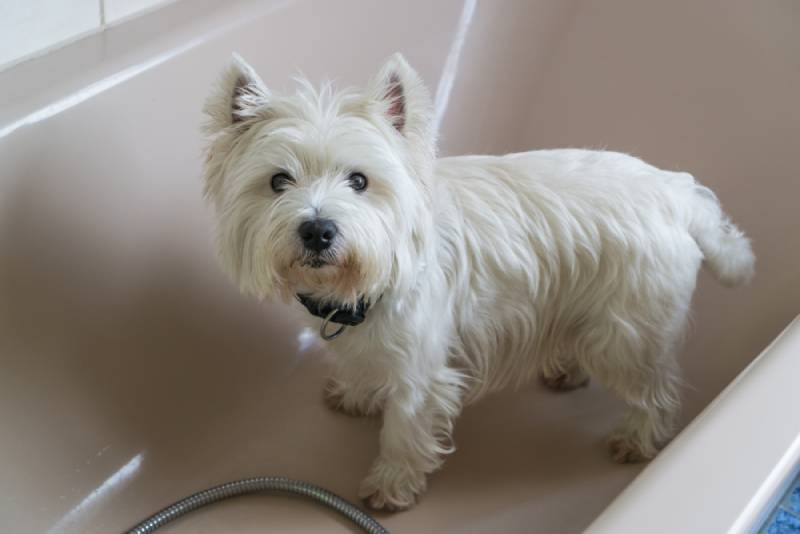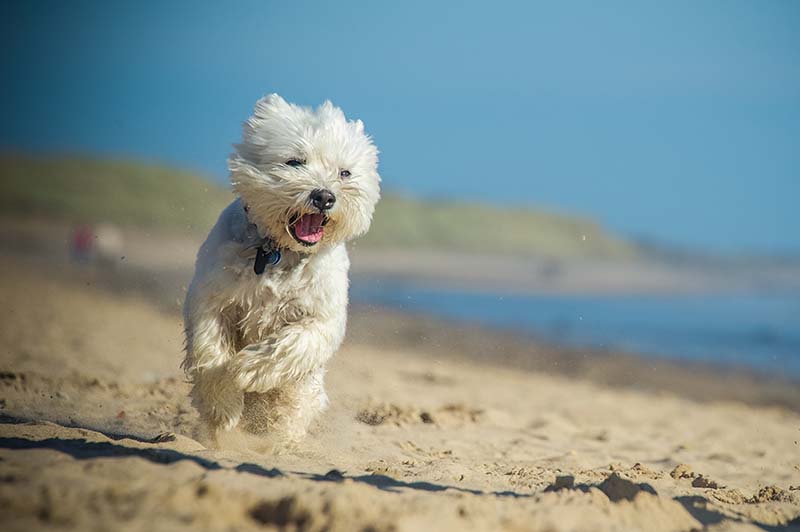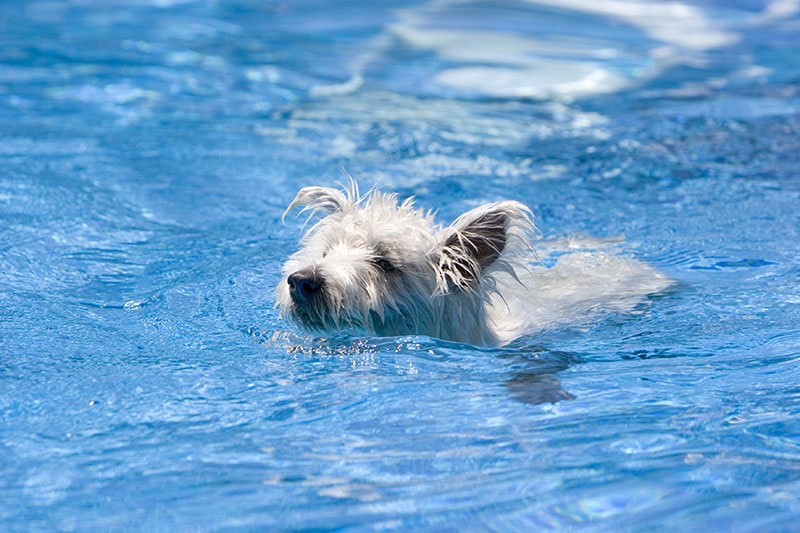Click to Skip Ahead
Very few dogs are as cute as the West Highland White Terriers. They are cheerful, playful, and tough, despite their size. Like most pooches, Westies are full of energy and happy to spend time with their favorite humans. But can they swim, though? Technically, yes, it’s possible to teach Westies to swim. But they’re not the most gifted swimmers out there.
Originally, these dogs were brought up as rodent killers, not water rescue dogs. That said, if the pup starts early and grows to like being in the water, it will turn into a capable, fearless swimmer. So, how do you train a Westie for that? And how do you ensure its safety in a pool? Let’s find out!
West Highland White Terriers: Tiny, Yet Mighty
With an average weight of 15–20 pounds and a height of 10–11 inches, Westies aren’t the biggest dogs out there. They do, however, compensate for that with high energy levels, willingness to follow commands, and a very joyful, sweet-tempered personality. These pups are incredibly affectionate and good around children, which makes them a great pick for a big, loving family.
More importantly, Westies are much stronger than the average small pooch. Specifically bred to lay waste to underground pests like rats and hunt rabbits, West Highland White Terrier dogs are robust and efficient. Intelligent, strong-willed, and ready to handle tough work, Westies are also a bit stubborn. But, overall, they are eager to please and happy to follow your lead.

How Good Are These Dogs at Swimming?
Since every single dog is unique, there’s no telling whether your fur baby will like water or not. Some West Highland dogs do love to cool off in a pool or stretch their legs in a bigger body of water. That said, your pup might be a bit hesitant to step foot into the water, especially if it’s a bit cold. Thus, if the pet feels a bit anxious in water, give it space to build up confidence.
Just like a human child that’s introduced to something new for the first time, the Westie will only step foot into the pool once it feels safe. Also, if you adopted the dog when it was an adult, chances are, it had a bad experience in the past that’s making it uncomfortable around water. So, easy does it! Try to evoke curiosity instead of being pushy or angry at the furry bud.
Do Westies Like to be Bathed?
Again, this depends on the dog. Some Westies are head over heels for taking a long, soothing bath. Others will easily tolerate it to get clean (and to please the owners) but won’t be very enthusiastic about it. And then there are Westies that will hate every second of taking a shower. Here’s hoping your pup loves to be around water!

 The 8 Steps to Introducing a Westie to a Floating Device
The 8 Steps to Introducing a Westie to a Floating Device
This is a short-legged dog, meaning it has a disadvantage in water compared to other breeds. Thankfully, getting a life vest for the pup will make it more comfortable. This is especially true if you want to begin with pool swimming. Life jackets, in turn, help canines stay afloat without putting much effort and remain visible at all times. Both devices can give Westie the courage to start making baby steps.
Your goal at this point should be to support the dog’s endeavors yet let it figure things out on its own. With a vest/jacket on, the pup will have time to process the surroundings and start paddling instead of panicking. Canines that have never been in water have somewhat slow reflexes. Plus, without a floating device, first-time swimmers only use their front legs for paddling.
When picking a life jacket/vest, consider the following:
- Look for a device that’s crafted from waterproof materials.
- See that it’s sturdy and durable enough for a Westie.
- Buy a bright jacket or vest with a reflective trim.
- The vest should fit snugly yet give the dog room for maneuvers.
- Try a dozen of devices until you find the most comfortable one.
- If the device has a D-ring, it can be attached to a leash.
- Ideally, the vest or jacket should have a handle for control.
- Extra support for the pup’s chin will come in handy as well.

Can You Train These Pups Into Better Paddlers?
The short answer is yes, it’s possible, but only if the dog is into it. For this to work, you need to be very gentle rather than expect the pup to turn into a top-notch diver overnight. In contrast to Golden Retrievers, Cocker Spaniels, and Newfoundland dogs, Westies don’t feel at home in the water. Positive reinforcement is the most powerful tool in your hands.
Praise the four-legged bud for even the most trivial things like touching the water with its paws or sniffing around it. By creating a positive association with a pool, sink full of water, or a pond, you can show the pup that it will get snacks and praise for being around water. It will take the Westie a couple of quick dips to realize that the water is not the “enemy”.
- First, put the vest or jacket on the pup.
- Next, encourage it to enter the water with a toy or a treat.
- Always keep your hand on the handle just in case.
- Don’t pull or push the Westie. Let it make the first move.
- If the water is deep, you should also wear a floating device.
- Start with shallow water to make it easier on the pooch.
- If you have a friend with a water-friendly dog, ask them to join.
- By watching that other canine paddling, your pup might follow.
- Be generous with positive reinforcement to keep the dog interested.
- Look for signs of discomfort, anxiety, and fatigue.
- Be quick to move the pooch to dry land and let it rest.
Teaching the Dog How to Exit the Water
You might not give this much thought, but exiting the pool, pond, or lake is just as important as entering it. If you’re in the water with the dog, try focusing Westie’s attention on the shore or ramp. If you’re outside, standing right next to the exit will help the dog figure out where it can get out. Repeat this several times to help the dog memorize the safest ways to escape the water.
 Top 12 Tips to Keep a Westie Safe in Water
Top 12 Tips to Keep a Westie Safe in Water
Dogs aren’t big fans of cool temps. If they stay in cold water for long, they’ll get the so-called swimmer’s tail. You might also catch the dog shivering, which calls for immediate medical attention. Hypothermia (dangerously low body temperature) is an even bigger emergency. This is especially true for puppies and senior dogs.
Next, watch out for water intoxication. The longer the Westie stays in the pool/lake, the more water it will consume, which might lead to hyperhydration and even poisoning. The most common side effects of this are nausea, lethargy, bloating, and vomiting. To avoid that, quickly treat the pup to some free-dried/dehydrated food to “handle” all that liquid in its tummy. Also, only keep the dog in the water for 5–10 minutes.
- Watch out for snakes, turtles, and alligators in the water.
- Try to protect the dog from fish hooks (dogs tend to swallow them).
- If the Westie bites the hook, take it to a vet immediately.
- Always have a fresh bottle of water ready for the dog.
- To prevent overheating, don’t go swimming when the sun is up.
- Or use sun protection and see that there’s a shady spot nearby.
- Avoid lakes/rivers/ponds with blue green algae. It’s toxic to dogs.
- Make the pool slip-resistant by using a rubber drainage mat.
- Teach the dog basic commands like “out”, “come”, and “leave it”.
- Provide supervision while the dog is in the water.
- Avoid big waves and currents and windy areas.
- Keep towels ready to dry the pup when it exits the water.
How Much Exercise Do These Dogs Need?
Earthdog events, agility, obedience, and rally—these are the sports/activities that Westies enjoy the most. They also wouldn’t mind a walk or hike around the block or short, intense running sessions. By nature, these pups have a frolic, playful, and mischievous personality with a stubborn streak. So, it would be best to keep them on a leash or let them loose in an enclosed area.
Westies aren’t exactly couch potatoes and prefer to stay on their feet instead of chilling on the floor. And, on average, they need at least an hour of exercise to stay fit and mentally stimulated. And some overly active pups can go on for 70–90 minutes, or more. To keep them excited, remember to switch things up a bit by introducing new games and activities into the pups’ daily routine.

Summary
Westies are capable, quick-to-learn dogs that like to run around, socialize, and play games. And, if you put your mind to it, you should be able to train, or, rather, help it become a decent swimmer. Just remember to be supportive and never push the pup. It could be that your dog is not fond of water/swimming, and that’s okay.
To avoid putting the fur baby through stress and discomfort, follow the simple, yet essential tips from our guide. Start slow, give the dog plenty of time to get used to being in the water, and go from there. Also, make sure to keep it nice and dry with a towel/blanket to protect it from bacteria.
- See also: How Much Does a Westie Cost?
Featured Image Credit: JD, Shutterstock




 The 8 Steps to Introducing a Westie to a Floating Device
The 8 Steps to Introducing a Westie to a Floating Device






